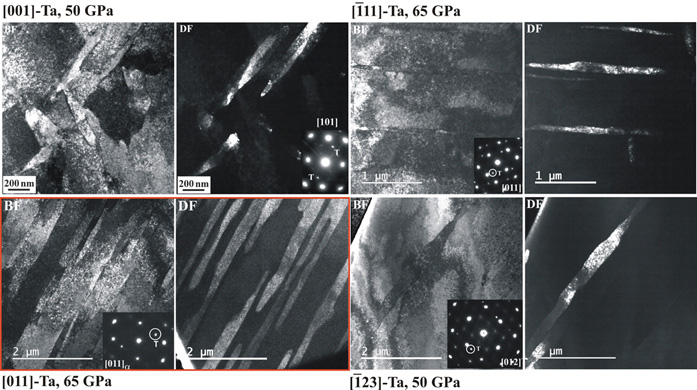Luke Hsiung (16-ERD-043)
Executive Summary
The goal of this project is to develop the capability to determine the mechanisms of high-rate plastic deformation in metals through dynamic recovery experiments, microstructure characterization, and modeling. Determining deformation mechanisms in materials under high stress loads impact various NNSA-related programs at Livermore, including high-energy-density and stockpile stewardship science.
Project Description
Deformation mechanisms in metals have been actively researched since the early 1950s, but the questions of what governs the slip-twinning and slip-phase transition and the relationship between dislocation structures and secondary deformation modes remain important open questions. In slip-twinning, a section of the atoms in the area of crystal under stress rearrange themselves into a mirror image of the original crystal’s structure, while in a slip-phase transition, planes of crystal slip past one another into a displaced pattern of deformation. These dislocation mechanisms have growing importance as multi-scale models are developed that rely on knowledge of mechanisms and need both guidance and validation. Understanding deformation mechanisms in materials with weapons-related applications is crucial to developing predictive models of the behavior of these materials. We plan to conduct three shock-impact experiments using Livermore’s gas-gun facility to drive body-centered-cubic single-crystal metal samples (in a body-centered cubic material, one lattice point of the crystal’s structure is at the center of a cube). These samples will be subjected to high pressures of greater than 25 GPa and up to 70 GPa, and high strain rates of 105 to 106 per second. We intend to explore the deformation mechanisms of these metals that are shock loaded under these extreme conditions. We will characterize the shock-recovered samples using scanning and transmission electron microscopy to determine what causes the slip-twinning and slip-phase transitions and the relationship between dislocation structures (the crystallographic defects within crystal structures) and secondary deformation modes—that is, deformation twinning (the plastic deformation of a crystal under stress by gliding along crystal planes) and material phase transformation. Our effort will focus on body-centered cubic metals because of their relevance to multi-scale model development.
The capability to determine deformation mechanisms will have an impact on the development of predictive constitutive materials models for weapons applications. With the increasing power of high-performance computers and multi-scale modeling techniques, it is becoming possible to develop constitutive models with parameters derived entirely from first principles. Our approach emphasizes the extraordinary detail provided by high-resolution transmission electron microscopy imaging of deformed materials, especially its unique ability to measure dislocation density and twin characteristics including size, morphology, and spatial distribution. We plan to use a gas-gun impact method to drive body-centered-cubic single-crystal metals (tantalum, molybdenum, or tungsten) at high rates and characterize the shock-recovered samples using x-ray diffraction, scanning electron microscopy, and transmission electron microscopy techniques. A successful outcome of our project will demonstrate that there is an intimate relationship between dislocation structures and secondary deformation modes in shock-loaded tantalum single crystals. This may enable further research opportunities by providing data and information needed to identify the relevant mechanisms to include in multi-scale modeling. Once the technique has been demonstrated for tantalum, we expect the approach can be applied to materials of interest to other research activities—there is a strong programmatic need for constitutive model development at Livermore. Our approach will build on two recognized strengths of Livermore: material dynamics (gas-gun experiments) and material characterization (scanning and transmission electron microscopy).
Mission Relevance
Material deformation models are typically formulated based on a working hypothesis and dominant mechanisms, guided by years of experience, but at low rates and low pressures. Experiments that directly determine deformation mechanisms in materials under high stress loads can have an impact on extending the Laboratory’s core competencies in high-performance computing (through improved material behavior modeling) and high-energy-density science (through high-stress experiments), as well as advancing its mission focus area in stockpile science. It is this need that we propose to address, determining the efficacy of a new capability for NNSA-related programs at Livermore.
FY17 Accomplishments and Results
In FY17 we (1) performed two separate shock experiments on single-crystal tantalum at 50 GPa and 65 GPa using the gas gun facility at California Institute of Technology, and a total of eight specimens with four different crystal orientations of [001], [011], [111], and [123] were successfully recovered (see figure); (2) analyzed the shock-recovered specimens using x-ray diffraction and transmission electron microscopy techniques, which revealed the onset of shock-induced twinning and/or phase transition in single-crystal tantalum shock loaded above 50 GPa; (3) further clarified, using transmission electron microscopy results, the crystal-orientation dependence of shock-induced twinning and phase transition, as well as the relationship between dislocation density and arrangement and shock-induced twinning and phase transition; and (4) determined that there exists a number density limit (in the range of 1012 to approximately 1013/cm2) for the evenly or randomly distributed dislocation structure in shocked tantalum, and above which dislocation multiplication sources become exhausted as the shear stress required for dislocation multiplication exceeds the threshold shear stress of about 2.8 GPa for deformation twinning or phase transition.
Publications and Presentations
Hsiung, L., and G. Campbell, 2017. "Transition of Dislocation Glide to Shear Transformation in Shocked Tantalum." MRS Advances 2 (27):1417–1428. doi: 10.1557/adv.2017.236. LLNL-JRNL-710038.






